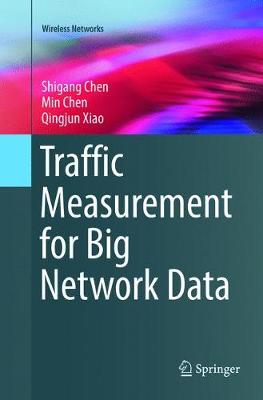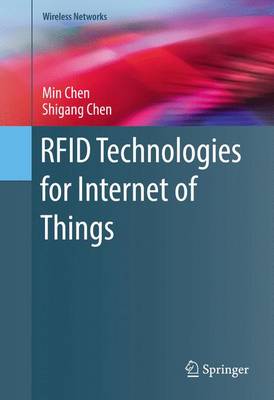Wireless Networks
2 total works
Traffic Measurement for Big Network Data
by Shigang Chen, Min Chen, and Qingjun Xiao
Published 10 November 2016
This book presents several compact and fast methods for online traffic measurement of big network data. It describes challenges of online traffic measurement, discusses the state of the field, and provides an overview of the potential solutions to major problems.
The authors introduce the problem of per-flow size measurement for big network data and present a fast and scalable counter architecture, called Counter Tree, which leverages a two-dimensional counter sharing scheme to achieve far better memory efficiency and significantly extend estimation range.
Unlike traditional approaches to cardinality estimation problems that allocate a separated data structure (called estimator) for each flow, this book takes a different design path by viewing all the flows together as a whole: each flow is allocated with a virtual estimator, and these virtual estimators share a common memory space. A framework of virtual estimators is designed to apply the idea of sharing to an array of cardinality estimation solutions, achieving far better memory efficiency than the best existing work.
To conclude, the authors discuss persistent spread estimation in high-speed networks. They offer a compact data structure called multi-virtual bitmap, which can estimate the cardinality of the intersection of an arbitrary number of sets. Using multi-virtual bitmaps, an implementation that can deliver high estimation accuracy under a very tight memory space is presented.
The results of these experiments will surprise both professionals in the field and advanced-level students interested in the topic. By providing both an overview and the results of specific experiments, this book is useful for those new to online traffic measurement and experts on the topic.
The authors introduce the problem of per-flow size measurement for big network data and present a fast and scalable counter architecture, called Counter Tree, which leverages a two-dimensional counter sharing scheme to achieve far better memory efficiency and significantly extend estimation range.
Unlike traditional approaches to cardinality estimation problems that allocate a separated data structure (called estimator) for each flow, this book takes a different design path by viewing all the flows together as a whole: each flow is allocated with a virtual estimator, and these virtual estimators share a common memory space. A framework of virtual estimators is designed to apply the idea of sharing to an array of cardinality estimation solutions, achieving far better memory efficiency than the best existing work.
To conclude, the authors discuss persistent spread estimation in high-speed networks. They offer a compact data structure called multi-virtual bitmap, which can estimate the cardinality of the intersection of an arbitrary number of sets. Using multi-virtual bitmaps, an implementation that can deliver high estimation accuracy under a very tight memory space is presented.
The results of these experiments will surprise both professionals in the field and advanced-level students interested in the topic. By providing both an overview and the results of specific experiments, this book is useful for those new to online traffic measurement and experts on the topic.
This book introduces applications of RFID on the Internet of things, under the emerging technologies for tag search, anonymous RFID authentication, and identification of networked tags. A new technique called filtering vector (a compact data structure that encodes tag IDs) is proposed to enable tag filtration, meeting the stringent delay requirements for real-world applications. Based on filtering vectors, a novel iterative tag search protocol is designed, which progressively improves the accuracy of search result and reduces the time of each iteration by using the information learned from the previous iterations. Moreover, the protocol is extended to work under noisy channel.
The authors also make a fundamental shift from the traditional design paradigm for anonymous RFID authentication by following an asymmetry design principle that pushes most complexity to the readers while leaving the tags as simple as possible. A novel technique is developed to dynamically generate random tokens on demand for authentication. The token-based authentication protocol only requires O(1) communication overhead and online computation overhead per authentication for both readers and tags.
Finally, the authors investigate the problem of networked-tag identification. The traditional contention-based protocol design will incur too much energy overhead in multihop tag systems, and a reader-coordinated design that significantly serializes tag transmissions performs much better. In addition, a solution based on serial numbers is proposed to achieve load balancing, thereby reducing the worst-case energy cost among the tags.
Designed for researchers and professionals, this SpringerBrief will interest individuals who work in efficiency, security, and privacy. Advanced-level students focused on network design will also benefit from the content.
The authors also make a fundamental shift from the traditional design paradigm for anonymous RFID authentication by following an asymmetry design principle that pushes most complexity to the readers while leaving the tags as simple as possible. A novel technique is developed to dynamically generate random tokens on demand for authentication. The token-based authentication protocol only requires O(1) communication overhead and online computation overhead per authentication for both readers and tags.
Finally, the authors investigate the problem of networked-tag identification. The traditional contention-based protocol design will incur too much energy overhead in multihop tag systems, and a reader-coordinated design that significantly serializes tag transmissions performs much better. In addition, a solution based on serial numbers is proposed to achieve load balancing, thereby reducing the worst-case energy cost among the tags.
Designed for researchers and professionals, this SpringerBrief will interest individuals who work in efficiency, security, and privacy. Advanced-level students focused on network design will also benefit from the content.

